| Article ID | Journal | Published Year | Pages | File Type |
|---|---|---|---|---|
| 1271060 | International Journal of Hydrogen Energy | 2012 | 8 Pages |
Planktic diatoms are the largest primary producers in marine and freshwater habitats. Their dry biomass accumulates up to 50% of lipids and contains water-soluble β-1,3-glucans as major storage products. Because of the world-wide abundance of these photosynthetic protists, β-1,3-glucans may rival cellulose as the polysaccharide with the highest annual production on Earth. Here we show the feasibility of a simple and efficient process leading to bio-hydrogen by dark fermentation of microalgal biomass with the thermophilic bacterium Thermotoga neapolitana. Production of the biogas on minimum medium supplemented only with the extract of the diatom Thalassiosira weissflogii proved that algal biomass per se can serve as substrate for sustaining the biotechnological process with no requirement of any pretreatment and external integration of other nutrients. At the same time, lipids unused for the anaerobic production of the biogas, can be employed for production of bio-diesel, thus considerably increasing the economic potential of these renewable feedstocks.
► Production of H2 from microalgal biomass by anaerobic fermentation in thermophilic conditions. ► Algal biomass sustains H2 production with no requirement of pretreatment and other external inputs. ► Gas production is compatible with further conversion of microalgal oil to biofuel. ► The process leads to 1 mol of H2 per mole of CO2 fixed by the photosynthetic algae.
